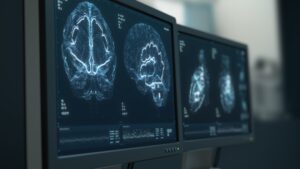People with Alzheimer’s disease develop defects in cognitive functions, such as memory, as well as problems with non-cognitive functions that can lead to anxiety and depression. In an article published April 6 in the journal Cell Stem Cell, researchers used mice to study a process by which new neurons are created in adulthood, called adult hippocampal neurogenesis (AHN). Neurogenesis refers to the production of new neurons in the brain. The research showed that deep brain stimulation of new neurons helped to restore both cognitive and non-cognitive functions in mouse models of Alzheimer’s disease. The neurons were altered by deep brain stimulation of the suprammamillary nucleus (SuM), located in the hypothalamus.
Activation of Adult Neurons by Deep Brain Stimulation Alleviates Alzheimer’s Symptoms
The researchers used two different mouse models of Alzheimer’s: optogenetics to stimulate SuM and enhance AHN in Alzheimer’s mice. Their previous research had shown that stimulating the SuM could increase the production of new neurons and improve their properties in normal adult mice. In the new study, the researchers showed that this strategy was also effective in the Alzheimer’s mice, leading to the creation of new neurons that made better connections to other parts of the brain. However, having more improved new neurons is not enough to boost memory and mood. Behavioral improvements in Alzheimer’s mice were only observed when these improved neurons were activated through chemogenetics. The researchers used memory tests as well as established assessments to look for anxiety-like and depression-like behaviors to confirm these improvements. The results suggest that a multi-step augmentation of new neurons – increasing their number, properties and activity – is required for behavioral recovery in Alzheimer’s brains.
To better understand the mechanism, they also analyzed the protein changes in the hippocampus of Alzheimer’s mice in response to the activation of SuM-modified adult-born new neurons. They found several well-known protein pathways that were activated within cells, including those known to be important for improved memory performance and those that enable clearance of Alzheimer’s-related plaques.
Future efforts by the team will focus on developing potential therapeutics that mimic the beneficial effects mediated by the activation of SuM-modified new neurons. Researchers hope these drugs could have therapeutic effects in patients with little or no hippocampal neurogenesis. Ultimately, the hope is to develop first-in-class, highly targeted therapies to treat Alzheimer’s and related dementia.
Exercise Helps to Build New Neurons
Previous research by a research team at Massachusetts General Hospital (MGH) found that neurogenesis can improve cognitive function in a mouse model of Alzheimer’s disease. The research suggests that these positive effects on cognition can be blocked by the hostile inflammatory environment in the brains of patients with Alzheimer’s disease, and that exercise can “clean up” the environment, allowing new nerve cells to survive and thrive, and cognition is improved. Exercise has been shown to be one of the best ways to turn on neurogenesis.
Adult neurogenesis—the production of new neurons that occurs after the embryonic and, in some animals, the neonatal period—occurs in the hippocampus and another brain structure called the striatum. While hippocampal neurogenesis is essential for learning and memory in adults, how this process affects neurodegenerative diseases such as Alzheimer’s disease is not fully understood. The MGH team investigated how impairment of adult hippocampal neurogenesis (AHN) contributes to the pathology and cognitive function of Alzheimer’s disease in a mouse model, and whether increasing neurogenesis could reduce symptoms.
Their experiments revealed that AHN could be induced in the model either by exercise or by treatment with drugs and gene therapy that promoted the birth of neural progenitor cells. Animal behavioral testing showed limited cognitive benefits for animals in which neurogenesis had been pharmacologically and genetically induced. But animals in which exercise-induced AHN showed improved cognitive performance and reduced beta-amyloid levels.
The key difference was that exercise also boosted the production of brain-derived neurotrophic factor, or BDNF — known to be important for neuron growth and survival — creating a more hospitable brain environment for new neurons. By combining drugs and gene therapy that both induced neurogenesis and increased BDNF production, the researchers were able to successfully mimic the effects of exercise on cognitive function.
Specific Peptide in the Fight Against Alzheimer’s

A new peptide could also be useful in the treatment of Alzheimer’s. This peptide blocks an overactive brain enzyme that contributes to the neurodegeneration that occurs in Alzheimer’s and other diseases. Neuroscientists at the Massachusetts Institute of Technology have found a way to reverse neurodegeneration and other symptoms of Alzheimer’s disease in mice by using a peptide that disrupts an enzyme that’s typically overactive in the brains of Alzheimer’s patients. When the researchers treated mice with a peptide that blocks the hyperactive version of an enzyme called CDK5, they saw a dramatic reduction in neurodegeneration and DNA damage in the brain. These mice also showed improvements in their ability to perform tasks like learning to navigate a water maze. With further testing, the researchers hope that the peptide could eventually be used to treat patients with Alzheimer’s and other forms of dementia with CDK5 overactivation. The peptide does not interfere with CDK1, an essential enzyme structurally similar to CDK5, and is similar in size to other peptide drugs used in clinical applications.
CDK5 is activated by a smaller protein that it interacts with, known as P35. When P35 binds to CDK5, the enzyme’s structure changes, causing it to phosphorylate its targets; can add a phosphate molecule. However, in Alzheimer’s and other neurodegenerative diseases, P35 is cleaved into a smaller protein called P25, which can also bind to CDK5 but has a longer half-life than P35. When bound to P25, CDK5 becomes more active in cells. P25 also allows CDK5 to phosphorylate molecules other than its usual targets, including the tau protein. Hyperphosphorylated tau proteins form the neurofibrillary tangles that are one of the defining features of Alzheimer’s disease. Pharmaceutical companies have tried to target P25 with small molecule drugs, but these drugs tend to cause side effects because they also interfere with other cyclin-dependent kinases, so none of them have been tested in patients.
The MIT team decided to take a different approach to fighting P25, using a peptide instead of a small molecule. They designed their peptide with a sequence identical to that of a segment of CDK5 known as the T-loop, a structure crucial for CDK5 binding to P25. In tests on neurons grown in a laboratory dish, the researchers found that treatment with the peptide led to a modest reduction in CDK5 activity. These tests also showed that the peptide neither inhibits the normal CDK5-P35 complex nor affects other cyclin-dependent kinases. When the researchers tested the peptide in a mouse model of Alzheimer’s disease with overactive CDK5, they saw a variety of positive effects, including reducing DNA damage, neural inflammation and neuron loss. These effects were much more pronounced in the mouse studies than in cultured cell tests. In addition to these effects in the brain, the researchers also observed behavioral improvements. Mice treated with the peptide performed much better on a task that required navigating a water maze than mice treated with a control peptide (an encoded version of the peptide used to inhibit CDK5-P25).
The researchers also analyzed the changes in gene expression that occur in mouse neurons after treatment with the peptide. Among the changes observed was an increase in the expression of about 20 genes that are typically activated by a family of gene regulators called MEF2. MEF2 activation of these genes may confer resilience to cognitive impairment in the brain and people with tau entanglements, and the researchers suspect peptide treatment could have similar effects.
Special Nutritional Supplement for the Brain
Essential vitamins, antioxidants and phospholipids can help to protect the brain in old age in the best possible way. Substances such as inositol, NADH, Ginkgo biloba and Co-Enzyme Q10 can have a positive effect on brain function, concentration and memory, and help regulate the energy balance in the cells.



